Art World
How Does an Artist Get a Gallery, Anyway? Here Are 11 Practical Steps That Could Lead to Bona Fide Representation
Artists, dealers, and other experts talk about what it takes to win the eye of a gallery.
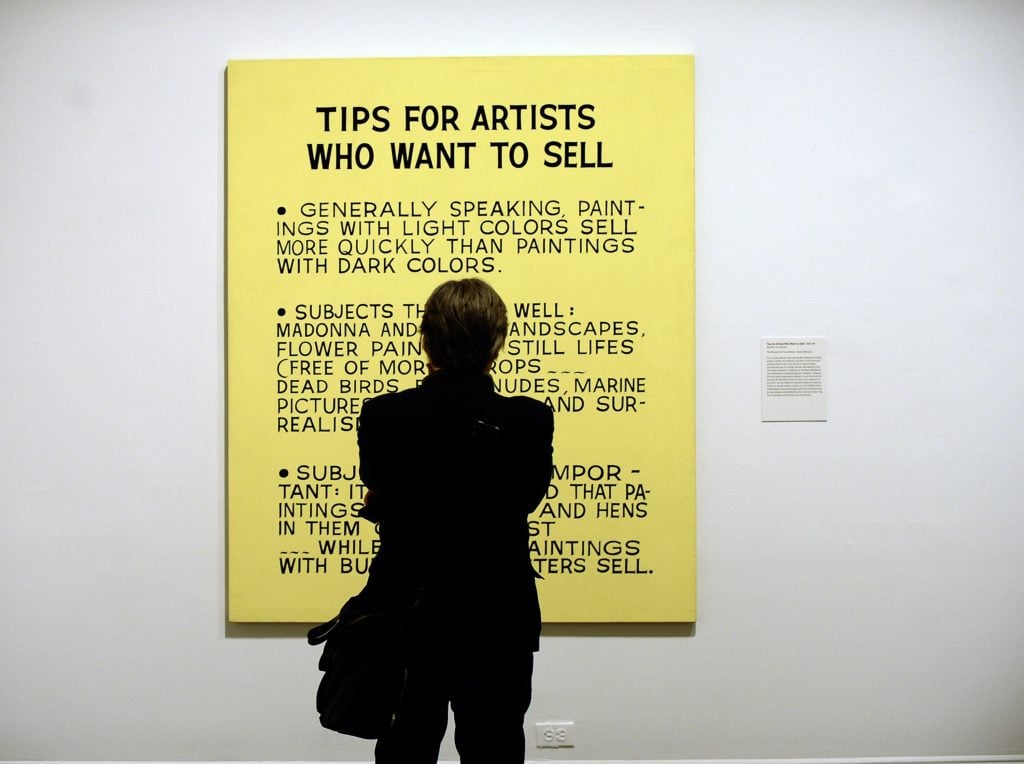
Artists, dealers, and other experts talk about what it takes to win the eye of a gallery.

Brian Boucher

Every year sees many thousands of newly credentialed artists, bearing degrees in the fine arts, looking to make their stamp in the art world. While there are numerous paths to success, many artists, young and not so young, are seeking the same goal: a gallery to show and sell their work to collectors and museums, to help them mount successful exhibitions, and maybe even to subsidize the production of their work.
Of course, gaining a gallery isn’t the next step for every artist. Some are perfectly content to work day jobs that grant enough security to continue to create work; some have a busy schedule of residencies; some are able to build a résumé by exhibiting at nonprofits; some who focus on a research-based practice might even benefit from a few years in a studio art PhD program.
But if you are looking for a relationship with a dealer who will support and represent you, you’ll need to know how to get there—and the art world is notoriously opaque when it comes to such matters. Are there any tips for speeding up this painful process? We asked both artists and dealers for advice on practical steps to gaining representation. Here’s what the experts had to say.
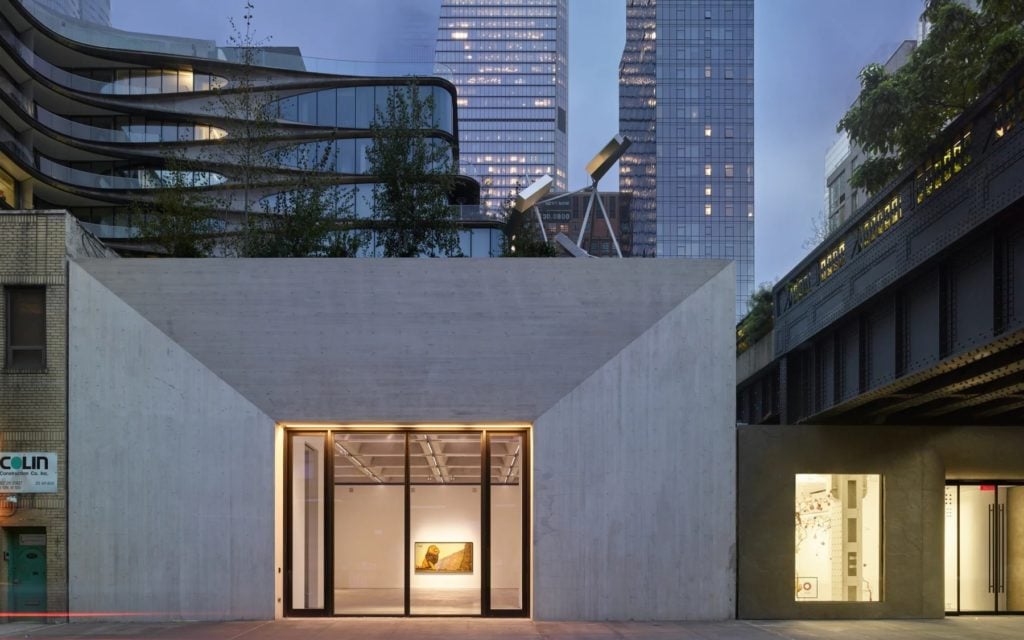
The exterior of Kasmin Gallery in Chelsea. Courtesy of Kasmin Gallery.
Before the “do’s,” let’s just get one “don’t” out of the way. If there is one tactic everyone artnet surveyed strongly discouraged, it is showing up unannounced at a gallery with a portfolio of your work. This is just not the way to do things.
“That’s the worst thing you could ever do,” said Christopher Rivera, co-founder (with Manuela Paz) of Embajada Gallery, in San Juan, Puerto Rico. “It’s a cliché. You look desperate.”
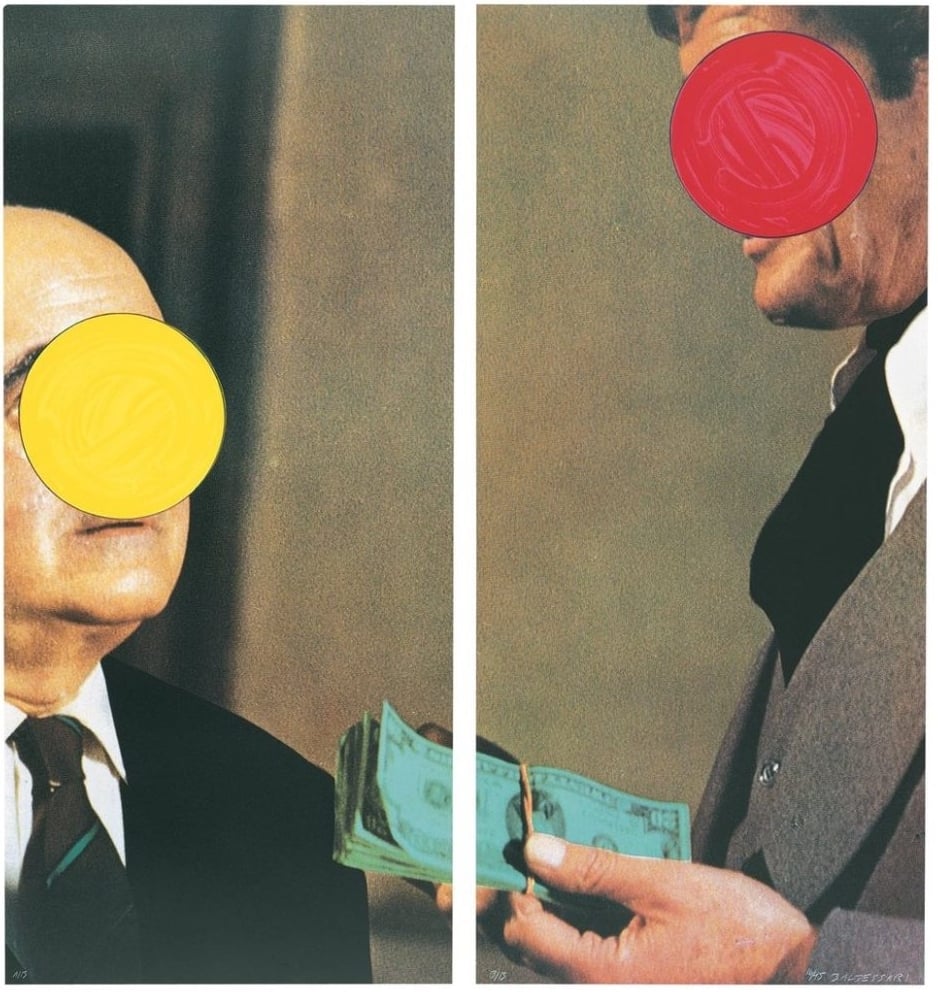
John Baldessari, Money (with Space Between), (1991) courtesy Gemini G.E.L.© John Baldessari.
When trying to make a career in art, one principle has to be in “the DNA that carries through every decision you make,” says Lauren Wittels, partner at New York gallery Luhring Augustine: “Your work has value.”
While it’s important get your work out there, reputation is important too. There is no shortage of unscrupulous people who will happily exploit artists’ eagerness for an opportunity—potentially setting a precedent for how others see them further down the line.
“Don’t give [art] to people who are not going to treat you and your work with respect,” says Wittels, who also teaches in the Bronx Museum’s AIM professional development program for artists. “There has to be a consignment agreement specifying insurance, terms of payment, shipping arrangements, and so on. If they want to put your paintings in the back of a car and say they’ll send a consignment later, no.”
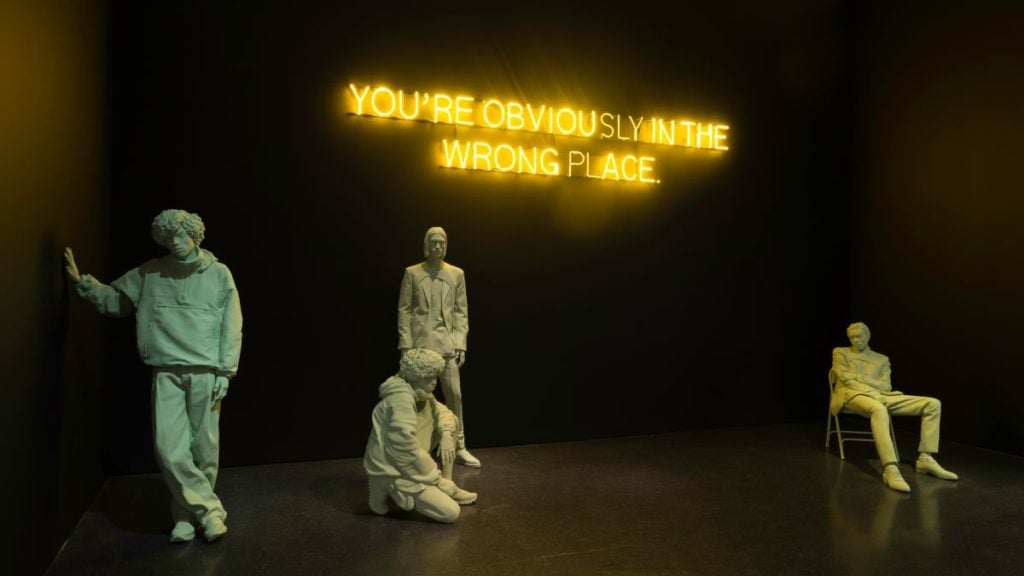
Installation view “Virgil Abloh: Figures of Speech” at MCA Chicago. © Nathan Keay, Courtesy of MCA Chicago.
In the economy in general, study after study has shown that most jobs are never posted, and upwards of 70 percent of all jobs are found through personal contacts or networking. In a small, personal field like art, these effects are only amplified—so it’s very important for artists to define for themselves what scene they are a part of and what networks they are attached to.
“You have to be part of a scene, part of a group of artists,” Rivera advises. Cohorts that form in school or in residency programs have to share contacts and opportunities, he says. The most common path an artist finds to success is through another artist who has found success.
Sharing goes both ways, Wittels points out. “If you’re in a show about, say, performance and the body, and you have a friend whose work explores those issues, recommend them!”
The art world is fiercely competitive, which can lead artists to guard their contacts jealously. Wittels assures aspiring artists that there’s enough opportunity to go around. “It’s human nature not to want others to steal opportunities,” she says, “but a lot of the artists in our gallery came through other artists.”
Hank Willis Thomas, who shows with the major New York gallery Jack Shainman, found his way through dumb luck and some help from his friends. “Someone I was in graduate school with was working as an art handler at Jack’s. They had a show of mostly African-American artists of my generation, organized by Trevor Schoonmaker and Isolde Brielmaier. He told Jack’s business partner, Claude Simard, ‘If you like that, you might like this.’”

Rebecca Morgan, Assortment of Face Jugs at Asya Geisberg Gallery. Photo: Cait Munro
Nothing can substitute for being a regular presence at the place you want to be, say the experts.
Artist Rebecca Morgan hosts “ask me anything” sessions for artists via her Instagram, dealing with this very subject. “You should make the effort to attend all the programming that you can at galleries you like,” says the artist, who is currently preparing a solo show at New York’s Asya Geisberg Gallery. “By being present and showing up, you will become a familiar face. I think it’s helpful to post pictures from the opening or exhibition; galleries are also always looking at who is present and attending. In my experience, they almost always check out who is posting or signing the book, or who is a regular attendee.”
Rivera is even more blunt: “You’ve got to go to openings! You’ve got to suffer! Either you can waste time going to the movies or you can go to an opening and then go to the after party.”
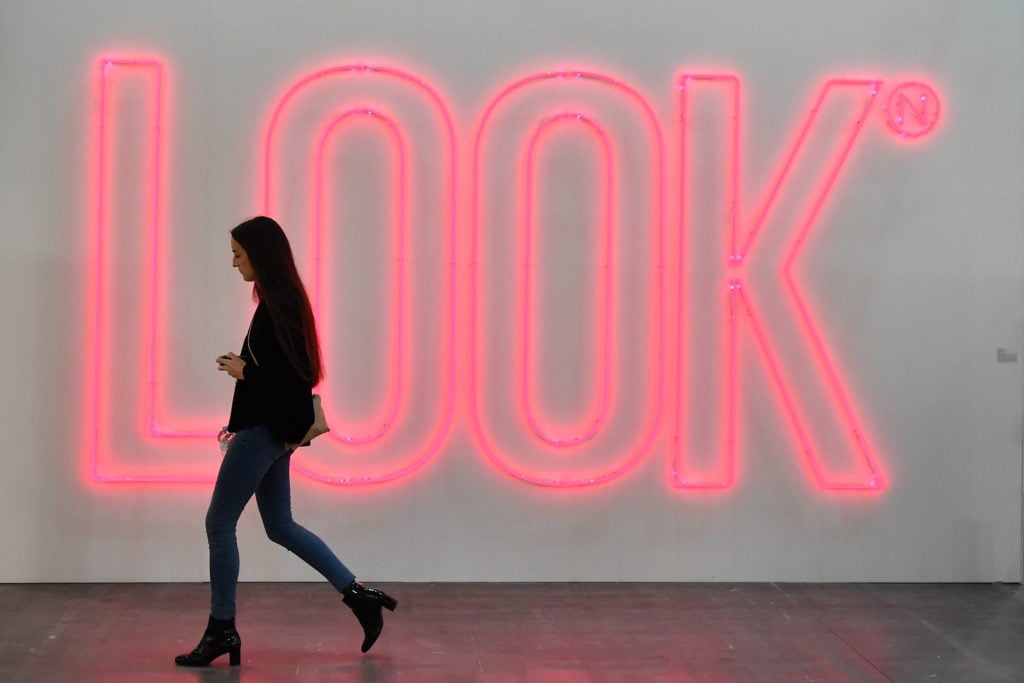
The opening of Artissima, International Fair of Contemporary Art on November 2, 2017 in Turin, Italy. Photo by Valerio Pennicino/Getty Images.
A light touch and a measure of sincerity are important, according to Morgan. “You should introduce yourself to the gallery owner or manager, or other artists in the stable, with nothing more than ‘I have been coming to this gallery for a while and I really love the exhibitions and wanted to say hello,'” she says. “Actual, real relationships happen from saying ‘Hello, I really admire you’ or ‘I like your program.’”
Nota bene: That part about “liking the program” is key. A very common mistake is for artists to look at the problem of getting a gallery indiscriminately, as if all galleries are the same. Knowing what, specifically, a certain space specializes in, and why your art, in particular, would work for it, is very important if you want to be taken seriously.
“If you tell the person at the front desk that you admire the gallery, you really should be able to discuss some artists in the gallery’s program to show that you mean what you say, that you’re really interested in what they do and you’re not just looking for any gallery to work with you,” Wittels councils.
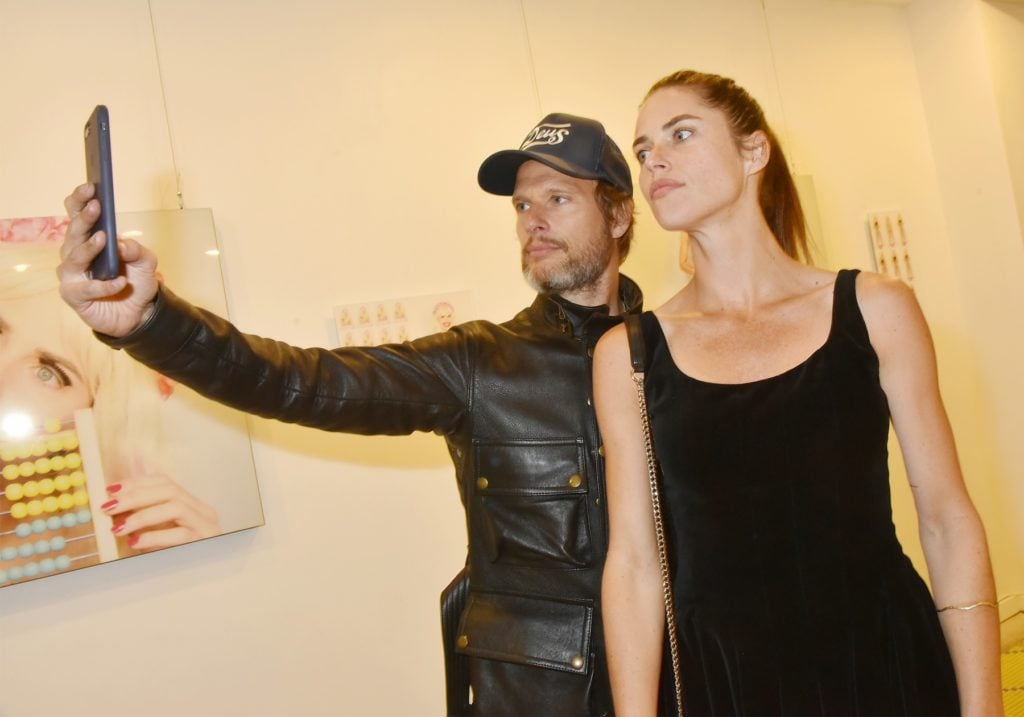
Artist Zoe Duchesne and a guest pose for a selfie during the “‘Poupees’ de Zoe Duchesne” preview at Galerie Marguerite Milin on September 13, 2018 in Paris, France. Photo by Foc Kan/WireImage.
Instagram and other social media are fine tools for artists. They have offered ways to network and gain exposure that previous generations just didn’t have, opening new entryways into the profession.
But keep in mind, not all exposure is created equal.
“I was just talking to an artist who was getting ready to reach out to a gallery and I looked at their Instagram,” Morgan says. “I had to tell them, ‘Look, I don’t see any of your work. I see selfies.’ Be mindful of what it’s going to look like when people are trying to find your work. Get your house in order.”
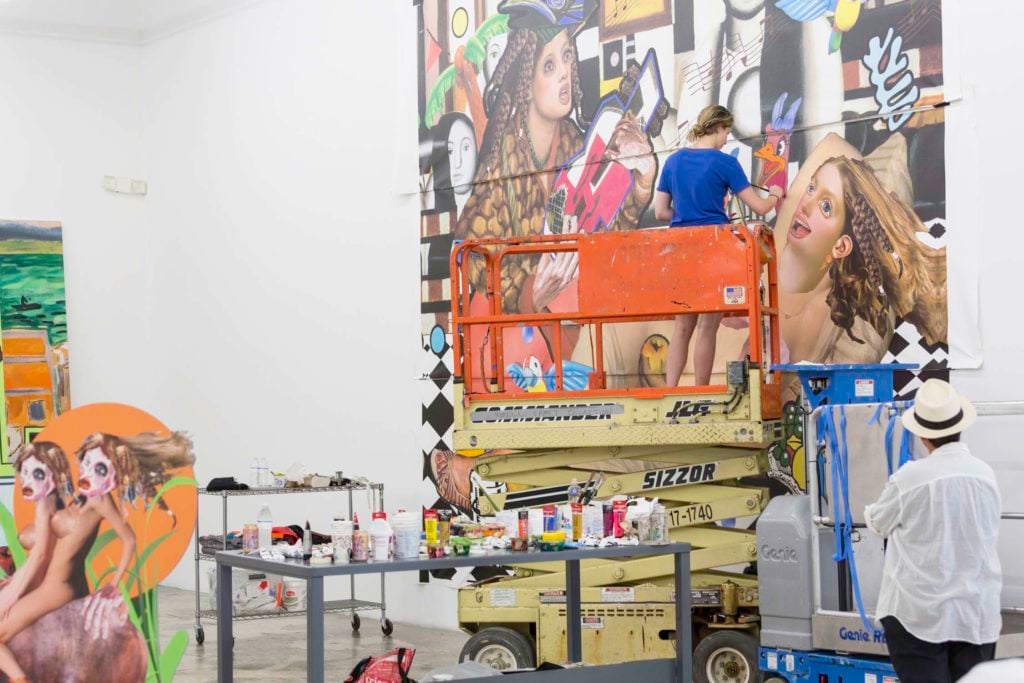
Allison Zuckerman in the summer of 2017. Courtesy of Kravets Wehby Gallery and Rubell Family Collection.
A studio visit is almost always the first step toward a gallery relationship, Wittels points out, so it’s important to know some basic protocol. “There has got to be a respectful dialogue,” she says. “It can’t be a monologue on either side. If you’re going to lecture me, you could just send a press release.”
On the flip side, it’s important actually to listen to what your visitor wants to say, Wittels advises. “Let them tell you their ideas about your work, or what other artists your work reminds them of. You want them to see things you’ve never thought of before.”
Also worth keeping in mind: You’ll need to have a healthy amount of work to show your visitor. “I’ve been to studio visits where there was one painting there,” Wittels says. Referring to Jay DeFeo’s ten-foot-tall masterpiece, she adds, “unless it’s The Rose, there better be more than one!”
Then again, don’t overdo it. “I’ve had studio visits where I’ve seen fifty paintings. There has to be a happy medium between the extremes.”
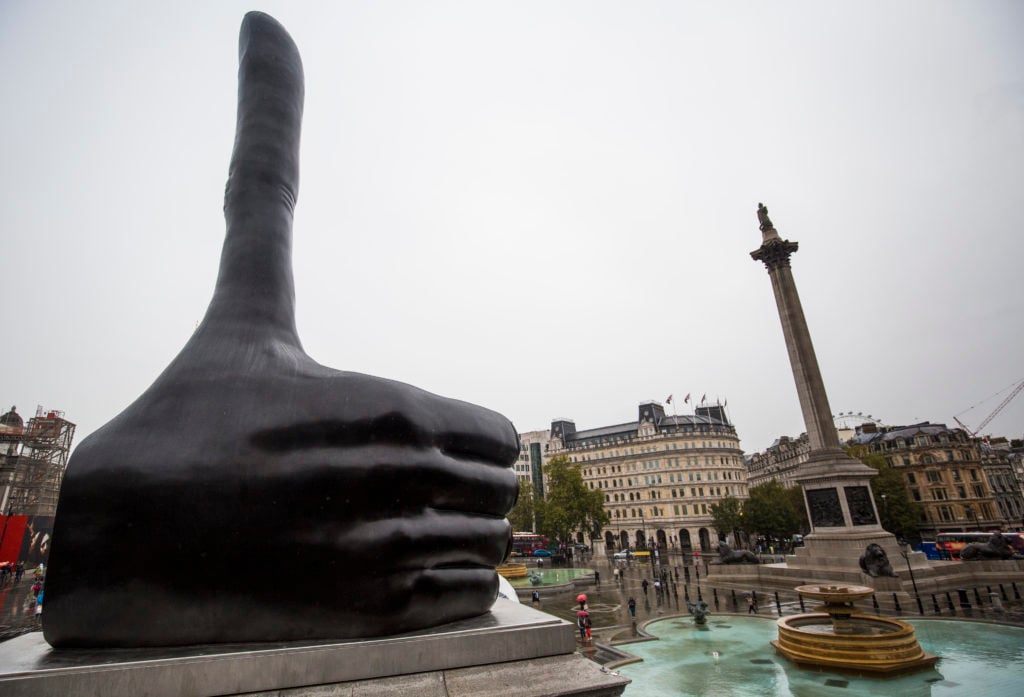
The Fourth Plinth sculpture by British artist David Shrigley, ‘Really Good’ is unveiled at Trafalgar Square on September 29, 2016 in London, England. (Photo by Jack Taylor/Getty Images)
There is a lot of rejection baked into art, an inherently demoralizing condition. It’s worth remembering that this is totally normal. Don’t let it rattle your self-confidence too much.
“I’ve been giving people the same advice about putting yourself out there,” says Morgan, “and sometimes they have trepidation to do it. I completely understand how intense it is. Yes, it’s uncomfortable. Yes, there’s a hierarchy. People say, ‘I’m so shy or anxious, I can’t.’ But at the end of the day, you have nothing to lose and everything to gain.”
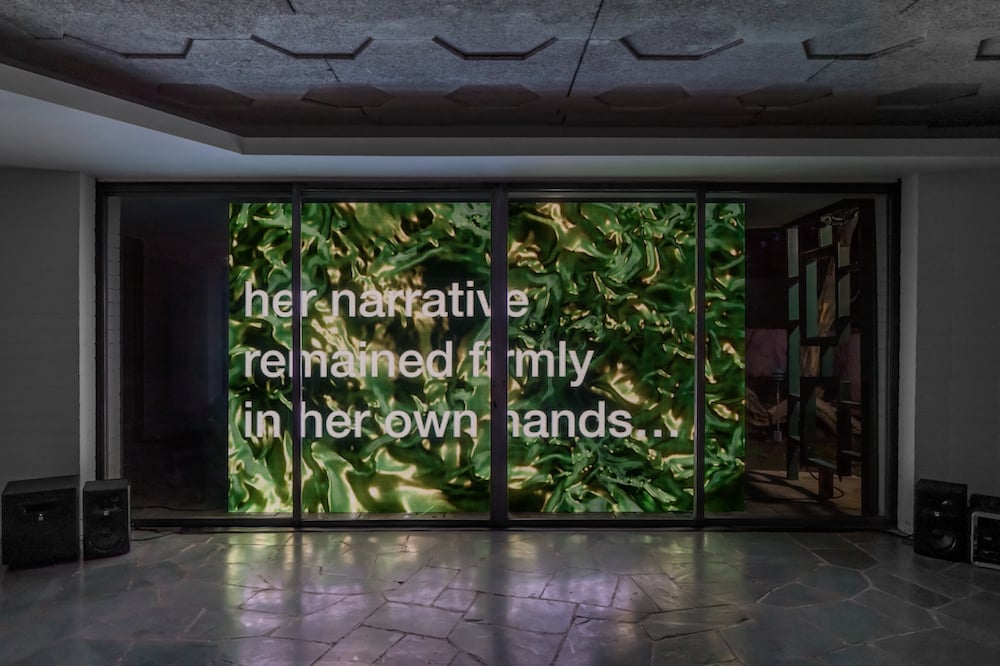
Tony Cokes, Della’s House (2019). Image courtesy the artist and Hannah Hoffman, LA. Photo: Elon Schoenholz.
“No one wants to hear this,” says the artist Tony Cokes, who works in video and recently signed to New York gallery Greene Naftali (and is presently in a two-person show with Oscar Murillo at The Shed in New York). “But this is how it happened: They asked me. It wasn’t a long campaign of socializing and insinuating myself into the program.”
Demanding video work like Cokes’s, which often deals with issues of race and representation, took him down an alternative path: It found a home at nonprofits and in festivals before he broke into the commercial world.
“I didn’t think the campaigning was going to work anyway,” says Cokes, who is a professor of modern culture and media at Brown University. “I hate to sound old-fashioned, but do work that you need to do and find possible venues for it. Make the work you want to make!”

Josh Kline, FREEDOM (2015) Image: Benoit Pailley. Courtesy the New Museum.
The bottom line is that there is always a risk for dealers in starting to show a new, unknown artist. The task is to get on the radar. Paradoxically, this means that the best way to get someone else to show your work is sometimes to start by showing yourself.
In an interview for the catalogue of the 2015 New Museum Triennial, the artist Josh Kline credited the huge role that the circle of peers around the former artist-run space 179 Canal had played in his career, and argued for the importance of artists creating their own spaces:
I think it’s essential for American artists to be curating—organizing exhibitions and starting project spaces—and finding ways to create platforms for themselves and their communities. In these spaces artists can present their peers and their ideas on their own terms, while providing the kind of nurturing exhibition environment that many artists need at the beginning of their careers but that is largely absent in the market and institutions. Since the financial crisis, conditions have genuinely opened up, creating other routes into the system for artists beyond expensive financially crippling graduate programs. A whole new wave of short-lived artist-run spaces (some more rigorous than others) has emerged after the crisis. The space that gave my community its start, 179 Canal, was one of the earliest out of the gate. The magic trick is finding a way to get the grown-ups to pay attention.
Morgan puts this even more bluntly. “Remove all the furniture from your apartment and start your own gallery!”, she says. “What are you going to do for yourself? How bad do you want this?”
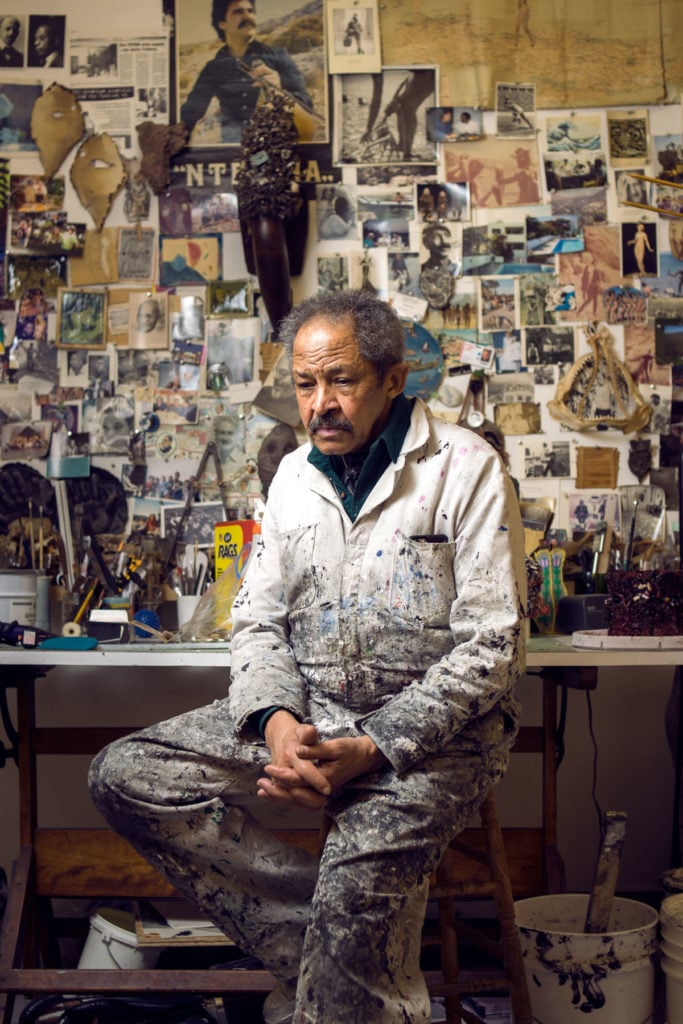
Jack Whitten in his studio, 2016. Photo by Taylor Dafoe.
As the art world has become more professionalized, it might be hard for a young artist not to feel impatient about finding representation. But in the end, it’s important to remind yourself that early success is more the exception than the rule, and that a lack of representation now certainly doesn’t rule out recognition later on.
“Some artists feel that if they haven’t made it by forty, then they haven’t made it,” says Hank Willis Thomas. “But there are so many artists just getting recognized in their sixties and seventies.” He rattles off a list of artists from Howardena Pindell and Lynn Hershman Leeson to Jack Whitten and MacArthur Binion, as well as his own mother, photographer Deborah Willis.
Wittels sounds a similar note. “The more art becomes a viable career path, the more pressure there is on artists,” she says. “Fifty years ago, just having a show in New York meant you were a success.”
Paraphrasing Shakespeare in Merchant of Venice, she assures young artists that if you keep at it, “the art will out.”